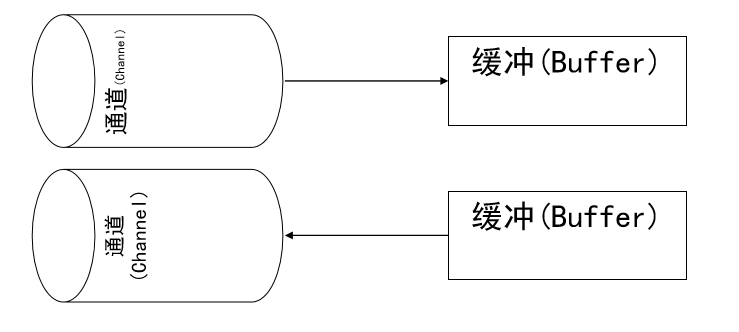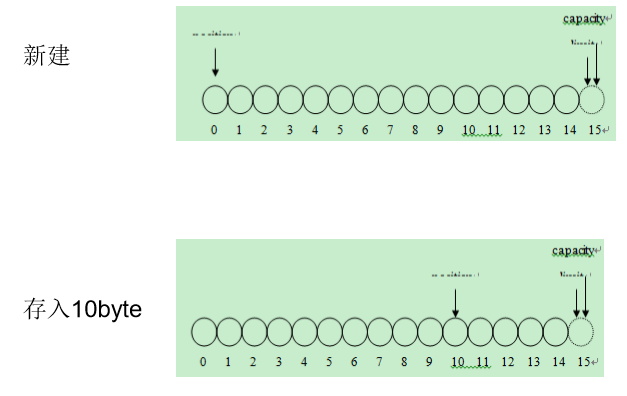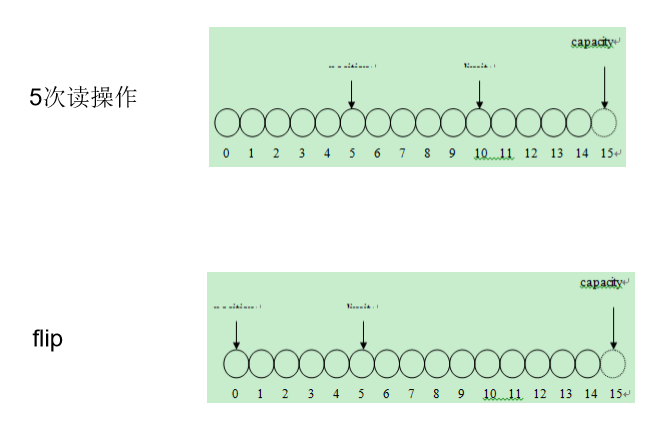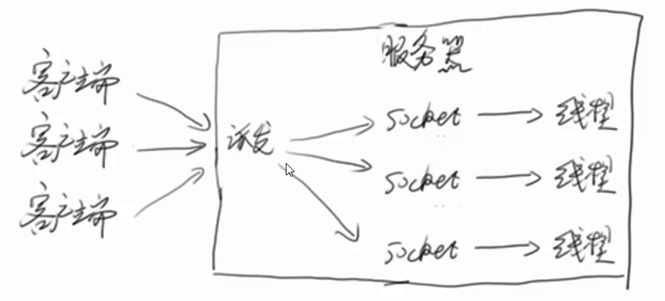NIO和AIO
2016-08-23 18:35
323 查看
摘要
本系列基于炼数成金课程,为了更好的学习,做了系列的记录。 本文主要介绍:1. 什么是NIO2. Buffer3. Channel4. 网络编程5. AIO
IO感觉上和多线程并没有多大关系,但是NIO改变了线程在应用层面使用的方式,也解决了一些实际的困难。而AIO是异步IO和前面的系列也有点关系。在此,为了学习和记录,也写一篇文章来介绍NIO和AIO。
NIO是基于块(Block)的,它以块为基本单位处理数据 (硬盘上存储的单位也是按Block来存储,这样性能上比基于流的方式要好一些)
为所有的原始类型提供(Buffer)缓存支持
增加通道(Channel)对象,作为新的原始 I/O 抽象
支持锁(我们在平时使用时经常能看到会出现一些.lock的文件,这说明有线程正在使用这把锁,当线程释放锁时,会把这个文件删除掉,这样其他线程才能继续拿到这把锁)和内存映射文件的文件访问接口
提供了基于Selector的异步网络I/O

所有的从通道中的读写操作,都要经过Buffer,而通道就是io的抽象,通道的另一端就是操纵的文件。

Java中Buffer的实现。基本的数据类型都有它对应的Buffer
Buffer的简单使用例子:
总结下使用的步骤是:
1. 得到Channel
2. 申请Buffer
3. 建立Channel和Buffer的读/写关系
4. 关闭
下面的例子是使用NIO来复制文件:
Buffer中有3个重要的参数:位置(position)、容量(capactiy)和上限(limit)

这里要区别下容量和上限,比如一个Buffer有10KB,那么10KB就是容量,我将5KB的文件读到Buffer中,那么上限就是5KB。
下面举个例子来理解下这3个重要的参数:
整个过程如图:

此时position从0到10,capactiy和limit不变。

该操作会重置position,通常,将buffer从写模式转换为读 模式时需要执行此方法 flip()操作不仅重置了当前的position为0,还将limit设置到当前position的位置 。
limit的意义在于,来确定哪些数据是有意义的,换句话说,从position到limit之间的数据才是有意义的数据,因为是上次操作的数据。所以flip操作往往是读写转换的意思。

意义同上。
而Buffer中大多数的方法都是去改变这3个参数来达到某些功能的:
将position置零,并清除标志位(mark)
将position置零,同时将limit设置为capacity的大小,并清除了标志mark
先将limit设置到position所在位置,然后将position置零,并清除标志位mark,通常在读写转换时使用
对MappedByteBuffer的修改就相当于修改文件本身,这样操作的速度是很快的。

简单的多线程服务器:
功能就是服务器端读到什么数据,就向客户端回写什么数据。
这里的tp是一个线程池,HandleMsg是处理消息的类。
客户端:
以上的网络编程是很基本的,使用这种方式,会有一些问题:
为每一个客户端使用一个线程,如果客户端出现延时等异常,线程可能会被占用很长时间。因为数据的准备和读取都在这个线程中。
因为
是阻塞的,所以时间都花在等待中。
如果用NIO来处理这个问题会怎么做呢?
NIO有一个很大的特点就是:把数据准备好了再通知我
而Channel有点类似于流,一个Channel可以和文件或者网络Socket对应 。

本系列基于炼数成金课程,为了更好的学习,做了系列的记录。 本文主要介绍:1. 什么是NIO2. Buffer3. Channel4. 网络编程5. AIO
IO感觉上和多线程并没有多大关系,但是NIO改变了线程在应用层面使用的方式,也解决了一些实际的困难。而AIO是异步IO和前面的系列也有点关系。在此,为了学习和记录,也写一篇文章来介绍NIO和AIO。
1. 什么是NIO
NIO是New I/O的简称,与旧式的基于流的I/O方法相对,从名字看,它表示新的一套Java I/O标 准。它是在Java 1.4中被纳入到JDK中的,并具有以下特性:NIO是基于块(Block)的,它以块为基本单位处理数据 (硬盘上存储的单位也是按Block来存储,这样性能上比基于流的方式要好一些)
为所有的原始类型提供(Buffer)缓存支持
增加通道(Channel)对象,作为新的原始 I/O 抽象
支持锁(我们在平时使用时经常能看到会出现一些.lock的文件,这说明有线程正在使用这把锁,当线程释放锁时,会把这个文件删除掉,这样其他线程才能继续拿到这把锁)和内存映射文件的文件访问接口
提供了基于Selector的异步网络I/O

所有的从通道中的读写操作,都要经过Buffer,而通道就是io的抽象,通道的另一端就是操纵的文件。
2. Buffer

Java中Buffer的实现。基本的数据类型都有它对应的Buffer
Buffer的简单使用例子:
package test;
import java.io.File;
import java.io.FileInputStream;
import java.nio.ByteBuffer;
import java.nio.channels.FileChannel;
public class Test {
public static void main(String[] args) throws Exception {
FileInputStream fin = new FileInputStream(new File(
"d:\\temp_buffer.tmp"));
FileChannel fc = fin.getChannel();
ByteBuffer byteBuffer = ByteBuffer.allocate(1024);
fc.read(byteBuffer);
fc.close();
byteBuffer.flip();//读写转换
}
}总结下使用的步骤是:
1. 得到Channel
2. 申请Buffer
3. 建立Channel和Buffer的读/写关系
4. 关闭
下面的例子是使用NIO来复制文件:
public static void nioCopyFile(String resource, String destination)
throws IOException {
FileInputStream fis = new FileInputStream(resource);
FileOutputStream fos = new FileOutputStream(destination);
FileChannel readChannel = fis.getChannel(); // 读文件通道
FileChannel writeChannel = fos.getChannel(); // 写文件通道
ByteBuffer buffer = ByteBuffer.allocate(1024); // 读入数据缓存
while (true) {
buffer.clear();
int len = readChannel.read(buffer); // 读入数据
if (len == -1) {
break; // 读取完毕
}
buffer.flip();
writeChannel.write(buffer); // 写入文件
}
readChannel.close();
writeChannel.close();
}Buffer中有3个重要的参数:位置(position)、容量(capactiy)和上限(limit)

这里要区别下容量和上限,比如一个Buffer有10KB,那么10KB就是容量,我将5KB的文件读到Buffer中,那么上限就是5KB。
下面举个例子来理解下这3个重要的参数:
public static void main(String[] args) throws Exception {
ByteBuffer b = ByteBuffer.allocate(15); // 15个字节大小的缓冲区
System.out.println("limit=" + b.limit() + " capacity=" + b.capacity()
+ " position=" + b.position());
for (int i = 0; i < 10; i++) {
// 存入10个字节数据
b.put((byte) i);
}
System.out.println("limit=" + b.limit() + " capacity=" + b.capacity()
+ " position=" + b.position());
b.flip(); // 重置position
System.out.println("limit=" + b.limit() + " capacity=" + b.capacity()
+ " position=" + b.position());
for (int i = 0; i < 5; i++) {
System.out.print(b.get());
}
System.out.println();
System.out.println("limit=" + b.limit() + " capacity=" + b.capacity()
+ " position=" + b.position());
b.flip();
System.out.println("limit=" + b.limit() + " capacity=" + b.capacity()
+ " position=" + b.position());
}整个过程如图:

此时position从0到10,capactiy和limit不变。

该操作会重置position,通常,将buffer从写模式转换为读 模式时需要执行此方法 flip()操作不仅重置了当前的position为0,还将limit设置到当前position的位置 。
limit的意义在于,来确定哪些数据是有意义的,换句话说,从position到limit之间的数据才是有意义的数据,因为是上次操作的数据。所以flip操作往往是读写转换的意思。

意义同上。
而Buffer中大多数的方法都是去改变这3个参数来达到某些功能的:
public final Buffer rewind()
将position置零,并清除标志位(mark)
public final Buffer clear()
将position置零,同时将limit设置为capacity的大小,并清除了标志mark
public final Buffer flip()
先将limit设置到position所在位置,然后将position置零,并清除标志位mark,通常在读写转换时使用
文件映射到内存
public static void main(String[] args) throws Exception {
RandomAccessFile raf = new RandomAccessFile("C:\\mapfile.txt", "rw");
FileChannel fc = raf.getChannel();
// 将文件映射到内存中
MappedByteBuffer mbb = fc.map(FileChannel.MapMode.READ_WRITE, 0,
raf.length());
while (mbb.hasRemaining()) {
System.out.print((char) mbb.get());
}
mbb.put(0, (byte) 98); // 修改文件
raf.close();
}对MappedByteBuffer的修改就相当于修改文件本身,这样操作的速度是很快的。
3. Channel
多线程网络服务器的一般结构:
简单的多线程服务器:
public static void main(String[] args) throws Exception {
ServerSocket echoServer = null;
Socket clientSocket = null;
try {
echoServer = new ServerSocket(8000);
} catch (IOException e) {
System.out.println(e);
}
while (true) {
try {
clientSocket = echoServer.accept();
System.out.println(clientSocket.getRemoteSocketAddress()
+ " connect!");
tp.execute(new HandleMsg(clientSocket));
} catch (IOException e) {
System.out.println(e);
}
}
}功能就是服务器端读到什么数据,就向客户端回写什么数据。
这里的tp是一个线程池,HandleMsg是处理消息的类。
static class HandleMsg implements Runnable{
省略部分信息
public void run(){
try {
is = new BufferedReader(new InputStreamReader(clientSocket.getInputStream()));
os = new PrintWriter(clientSocket.getOutputStream(), true);
// 从InputStream当中读取客户端所发送的数据
String inputLine = null;
long b=System. currentTimeMillis ();
while ((inputLine = is.readLine()) != null)
{
os.println(inputLine);
}
long e=System. currentTimeMillis ();
System. out.println ("spend:"+(e - b)+" ms ");
} catch (IOException e) {
e.printStackTrace();
}finally
{
关闭资源
}
}
}客户端:
public static void main(String[] args) throws Exception {
Socket client = null;
PrintWriter writer = null;
BufferedReader reader = null;
try {
client = new Socket();
client.connect(new InetSocketAddress("localhost", 8000));
writer = new PrintWriter(client.getOutputStream(), true);
writer.println("Hello!");
writer.flush();
reader = new BufferedReader(new InputStreamReader(
client.getInputStream()));
System.out.println("from server: " + reader.readLine());
} catch (Exception e) {
} finally {
// 省略资源关闭
}
}以上的网络编程是很基本的,使用这种方式,会有一些问题:
为每一个客户端使用一个线程,如果客户端出现延时等异常,线程可能会被占用很长时间。因为数据的准备和读取都在这个线程中。
spend:6000ms spend:6000ms spend:6000ms spend:6001ms spend:6002ms spend:6002ms spend:6002ms spend:6002ms spend:6003ms spend:6003ms
因为
while ((inputLine = is.readLine()) != null)
是阻塞的,所以时间都花在等待中。
如果用NIO来处理这个问题会怎么做呢?
NIO有一个很大的特点就是:把数据准备好了再通知我
而Channel有点类似于流,一个Channel可以和文件或者网络Socket对应 。

相关文章推荐
- Java 网络IO编程总结(BIO、NIO、AIO均含完整实例代码)
- JAVA 中BIO,NIO,AIO的理解
- JAVA中IO技术:BIO、NIO、AIO
- JAVA 中BIO,NIO,AIO的理解
- NIO,BIO,AIO,JAVA通讯编程学习笔记3
- BIO与NIO、AIO
- Java BIO,NIO,AIO的区别
- NIO和AIO
- Java中NIO、BIO、AIO相关概念及应用场景
- 也谈BIO | NIO | AIO (Java版--转)
- BIO,NIO,AIO的区别
- Java BIO, NIO, AIO 总结
- BIO,NIO,AIO的区别
- BIO ,NIO ,AIO
- Java BIO NIO AIO
- BIO、NIO、AIO
- Java 网络IO编程总结(BIO、NIO、AIO均含完整实例代码)
- Java 网络IO编程总结(BIO、NIO、AIO均含完整实例代码)
- java BIO NIO AIO 理论篇
- 五种I/O 模式,select、epoll方法的理解,BIO、NIO、AIO理解 相关文章
